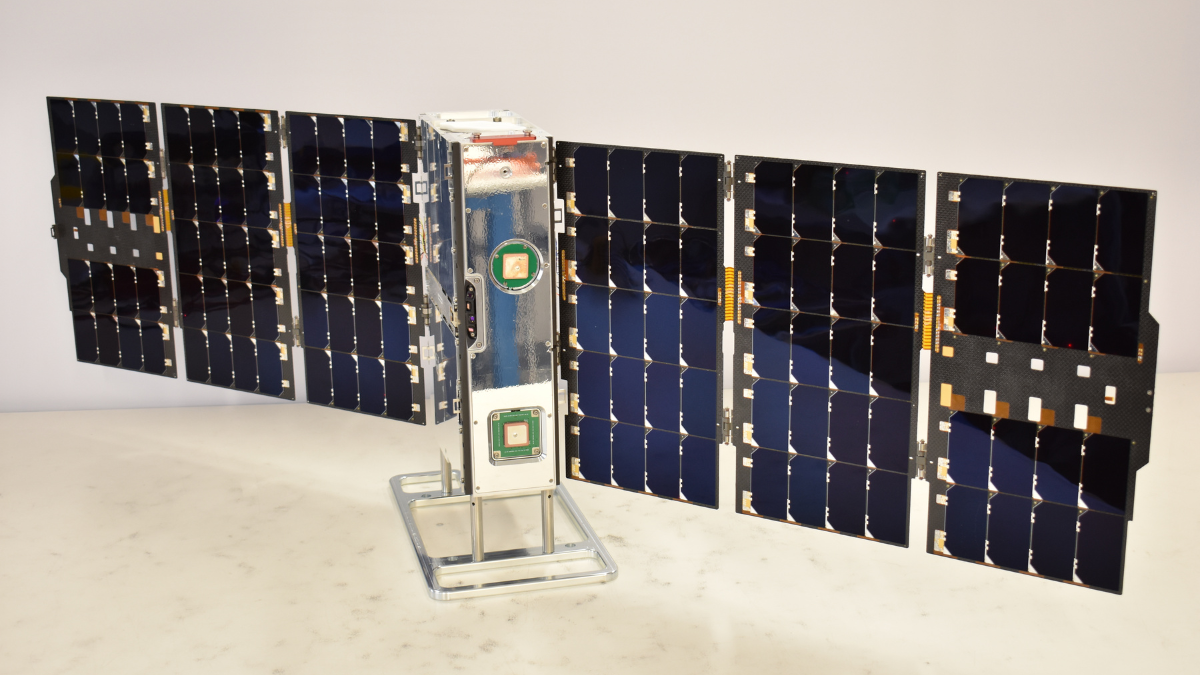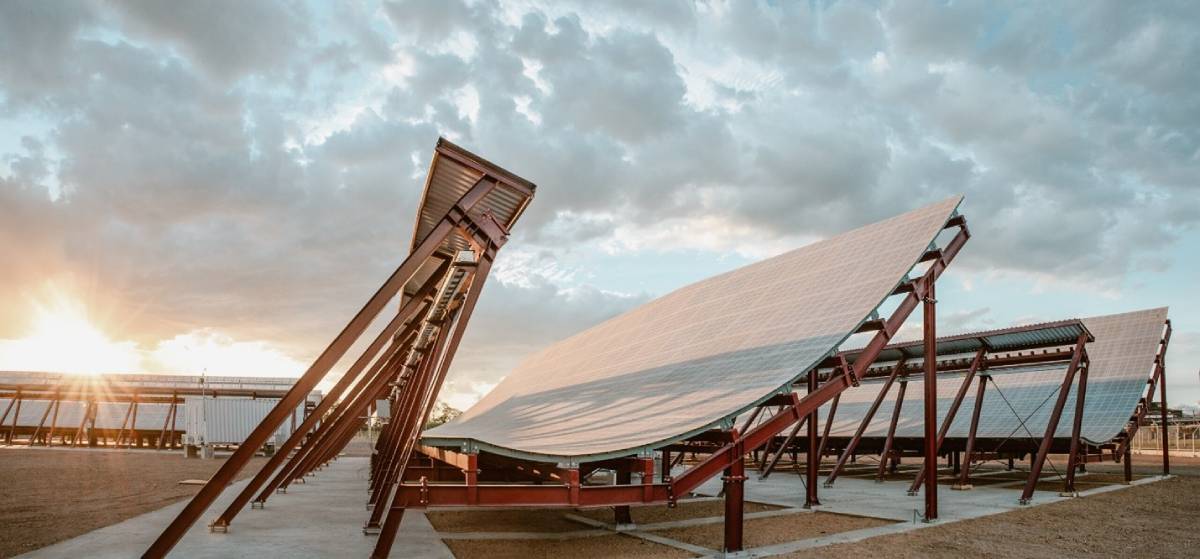 MIT Lincoln Laboratory’s Agile MicroSat (AMS), a 6U CubeSat built by Blue Canyon Technologies. (Source: MIT Lincoln Laboratory / Blue Canyon Technologies)
MIT Lincoln Laboratory’s Agile MicroSat (AMS), a 6U CubeSat built by Blue Canyon Technologies. (Source: MIT Lincoln Laboratory / Blue Canyon Technologies)
WASHINGTON — According to a new market report by Juniper Research, investment in Very Low Earth Orbit (VLEO) is estimated to reach $220B by 2027, compared to $17B in 2024. This projected increase in VLEO funding and activity is poised to unlock cutting-edge and never-before-seen satellite capabilities and services that will only continue to expand as access to the space domain becomes easier and more affordable.
What is VLEO?
Compared to the big three orbital planes – Geosynchronous (GEO), Medium Earth Orbit (MEO), and Low Earth Orbit (LEO) – VLEO is situated beneath LEO, making it the closest orbit in proximity to Earth.
Because VLEO satellites operate at an altitude of just 150-450 km above the Earth’s surface, they are better suited to meet today’s service demands for higher-resolution imaging, faster communications speeds, more frequent revisit monitoring and greater space operational efficiency. Today, VLEO is beginning to provide these enhanced capabilities to urban planning, disaster management, environmental monitoring and maritime industries.
When signals have a shorter distance to travel, data speeds and imaging clarity are greatly improved. The market research report states that this also applies to VLEO’s lower communications latency, as it facilitates far more accurate and reliable, real-time data transmission and responsive services compared to other orbits.
According to Juniper Research, reduced distance makes VLEO satellite services more economically viable, as lower data transmission power requirements will result in longer operational lifespans of satellites, a reduction of launches, and generally lower operational costs.
Is VLEO’s Moment Now?
Satellites have been launched into orbit for decades, providing an established sense of connectivity and communications services to the military, government and industry. So, what makes this moment in time the prime opportunity for VLEO to finally flourish and become a forecasted $220B market?
According to Elisha Sudlow-Poole, Senior Research Analyst at Juniper Research and co-author of the VLEO report, there have been several contributing factors to the growing utilization of the orbit.
“Technological advancements in CubeSats, nanosatellites, propulsion technology, material science including coatings and durability, as well as advancements in communications technologies, have been key to the increased commercialization of VLEO satellites,” said Sudlow-Poole.
Still, she noted, some current roadblocks exist that must be solved. “Factors like atmospheric drag, environmental stress - such as rapid transitions between the Sun and Earth's shadow - and sustainability are still key challenges associated with launching and maintaining VLEO satellites.”
Industry has responded to some of these environmental barriers and has begun to tackle them head-on. According to Karen McConnell, Executive Director of Spacecraft at Blue Canyon Technologies – RTX’s small satellite manufacturer and mission services provider – there have been many breakthroughs in material sciences that are contributing to VLEO’s rise.
“Atomic oxygen is the predominant gas species in VLEO and it is extremely reactive with many materials,” she said. “It causes shrinkage, cracking, erosion: all of which can change the optical, thermal and mechanical properties of the materials. To combat the issues with atomic oxygen, we’re improving our understanding of the environment and material development. Coatings and different materials that are atomic oxygen-resistant are becoming increasingly available.”
Another challenge that the orbit faces is ethics, which – according to Sudlow-Poole - will play a critical role in the success of VLEO utilization. “Whilst it is not necessarily a technology, the ethics of satellite access is something that must still be considered if the market is to move forward,” she said. “For example, one primary ethical concern revolves around the equitable access to orbital space and the frequency of space debris. This aspect is as important as the development of the technology themselves.”
Propulsion, Power Generation and Environmental Stress
According to Daniel Ceperley, COO of LeoLabs - a ground radar construction and operation company – advancement in propulsion technology has been one of the top enablers of VLEO successfully counteracting atmospheric drag. With breakthroughs in electric thruster technology, VLEO satellites are now equipped to continuously outpace the orbit’s velocity and maintain their position, without fear of being pulled back down to Earth.
“These VLEO satellites are coming down to the edge of the atmosphere,” said Ceperley. “The reason propulsion is so important is due to the constant drag that’s trying to pull satellites into the upper atmosphere. New propulsion technology is enabling VLEO satellites to continually fire their thrusters, allowing us to finally maintain a VLEO constellation.”
McConnell agreed that high-performance propulsion systems have been a VLEO gamechanger. “High-performing propulsion systems that are also moderate-to-low power and low-disturbance have been a barrier previously,” she explained. “Relatively high-performing propulsion systems that don’t require kilowatts of power are commonplace now. Electric propulsion thrusters capable of higher throughput are becoming more available. On the more advanced end of development, atmosphere-breathing thrusters are being developed, which would reduce the amount of propellant that has to be stored on-board.”
Ceperley also attributed the rise of VLEO constellations to the advancement in solar panels. A new generation of solar power solutions can generate the power that VLEO satellites require, while simultaneously being small enough to withstand atmospheric drag.
“[VLEO satellites] need a fair amount of electrical power,” Ceperley explained. “They need solar panels that can generate that power, but you don't want a huge deployed solar panel, because that will lead to atmospheric drag. You’re going to want smaller solar panels to be able to produce the necessary electricity to drive these thrusters. And you need to be able to source a lot of these electric thrusters that are able to perform. So, having a mature industry to execute and deliver on that has been quite important.”
Fulfilling the Ground Station Requirement
Ground stations also play a major role in VLEO. Due to VLEO satellites’ close proximity to Earth, they orbit around the globe faster than satellites in GEO, MEO and LEO. Having a sufficient number of teleports on the ground for satellites in which to transmit high-resolution imagery and other data will be required for VLEO constellations to be successful.
“With VLEO, satellites aren't over the ground stations for very long and the bandwidth is pretty limited,” said Ceperley. “Operators will need a lot of teleports on the ground for them to transfer data dumps and enable commanding and decision-making. For Earth imaging, there’s not enough bandwidth to get imagery back down to the ground. If you don't have a lot of ground stations, you’ll only be able to download very little data from your satellites.”
Ceperley explained that the ground station conundrum also applies to satellite connectivity services. “For connectivity, it’s the same sort of problem,” he said. “If you're getting signals from the users on the ground, you need to be able to route those over to a gateway on the ground. And you're not going to be in view of a single gateway for very long. In the past, there just weren't that many ground stations. But with these mega constellations, CubeSat networks and startups that are offering ground station networks for subscription, the world is finally starting to have the gateway networks that are required to make these VLEO constellations work.”
Situational Awareness in VLEO
 This image shows one of LeoLabs radar sites. (Source: LeoLabs/Daniel Ceperley)
This image shows one of LeoLabs radar sites. (Source: LeoLabs/Daniel Ceperley)
Ceperley highlighted that one challenge VLEO will begin to face - as satellites become more proliferated in the orbit - is situational awareness.
“VLEO satellites, due to their propulsion capabilities, are more maneuverable,” he explained. “They’re going to act differently than anybody's ever seen before. Satellite operators will need help not only steering around all the debris but also identifying and tracking malfunctioning satellites. When satellites malfunction in VLEO, operators must find them fast, or else the atmosphere is going to push it out of position very quickly.”
Ceperley explained that if malfunctioning satellites descend too far and aren’t swiftly recovered, there is a likely chance that the asset would be lost entirely. “If you're on the military side doing space domain awareness, VLEO poses a potentially proliferative threat,” said Ceperley. “VLEO satellites can make bigger maneuvers more frequently than what you expect. For VLEO to be successful, operators will need a more sophisticated situational awareness network that allows more eyes to be on the sky.”
Explore More:
Falling Debris and Near-Miss Collisions: Mitigating Risk in LEO
Podcast: Tracking LEOs, Growth in Resident Space Objects and the Problem with Uncertainty
Advances in Automation Show Strong Potential to Improve Space Situational Awareness
